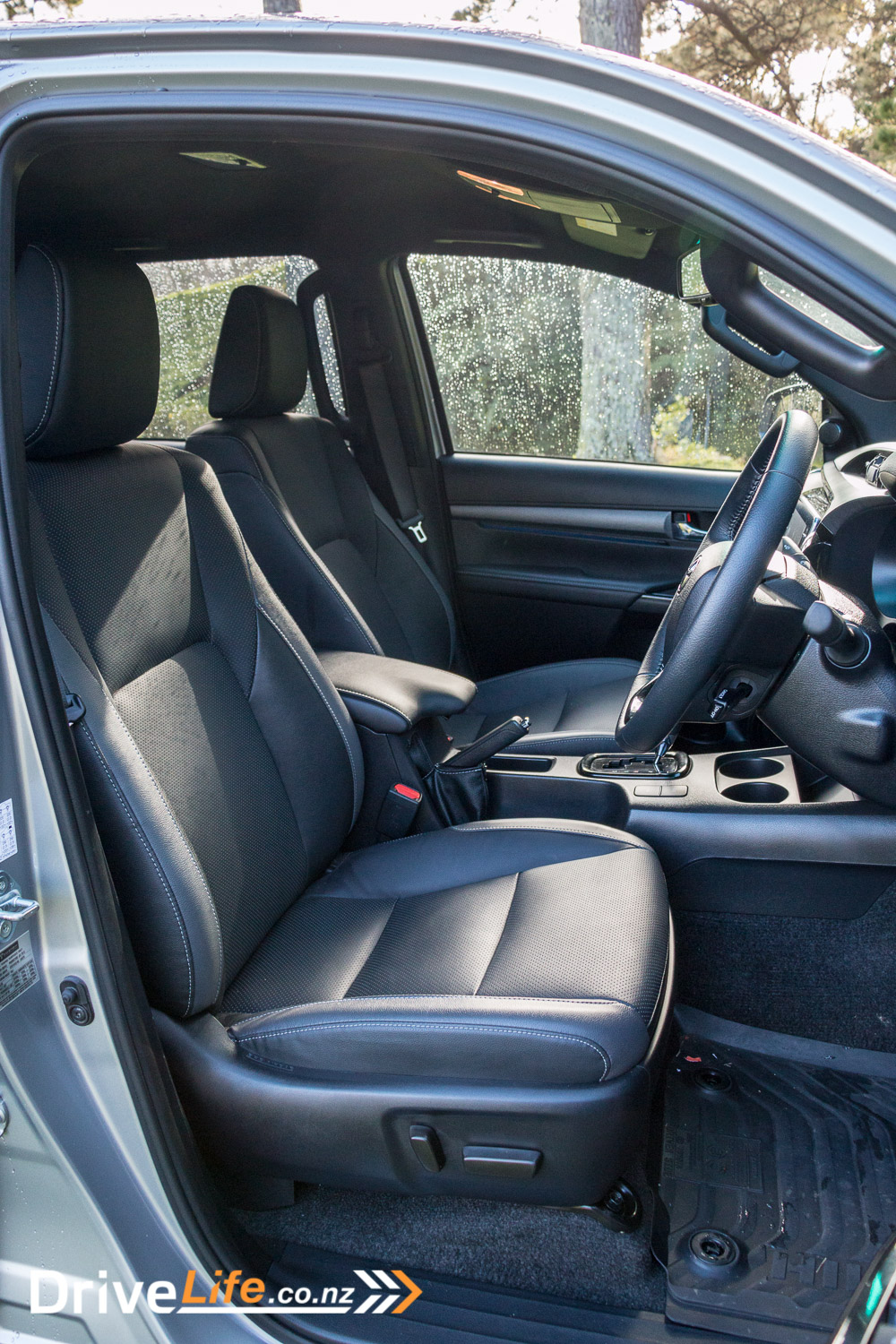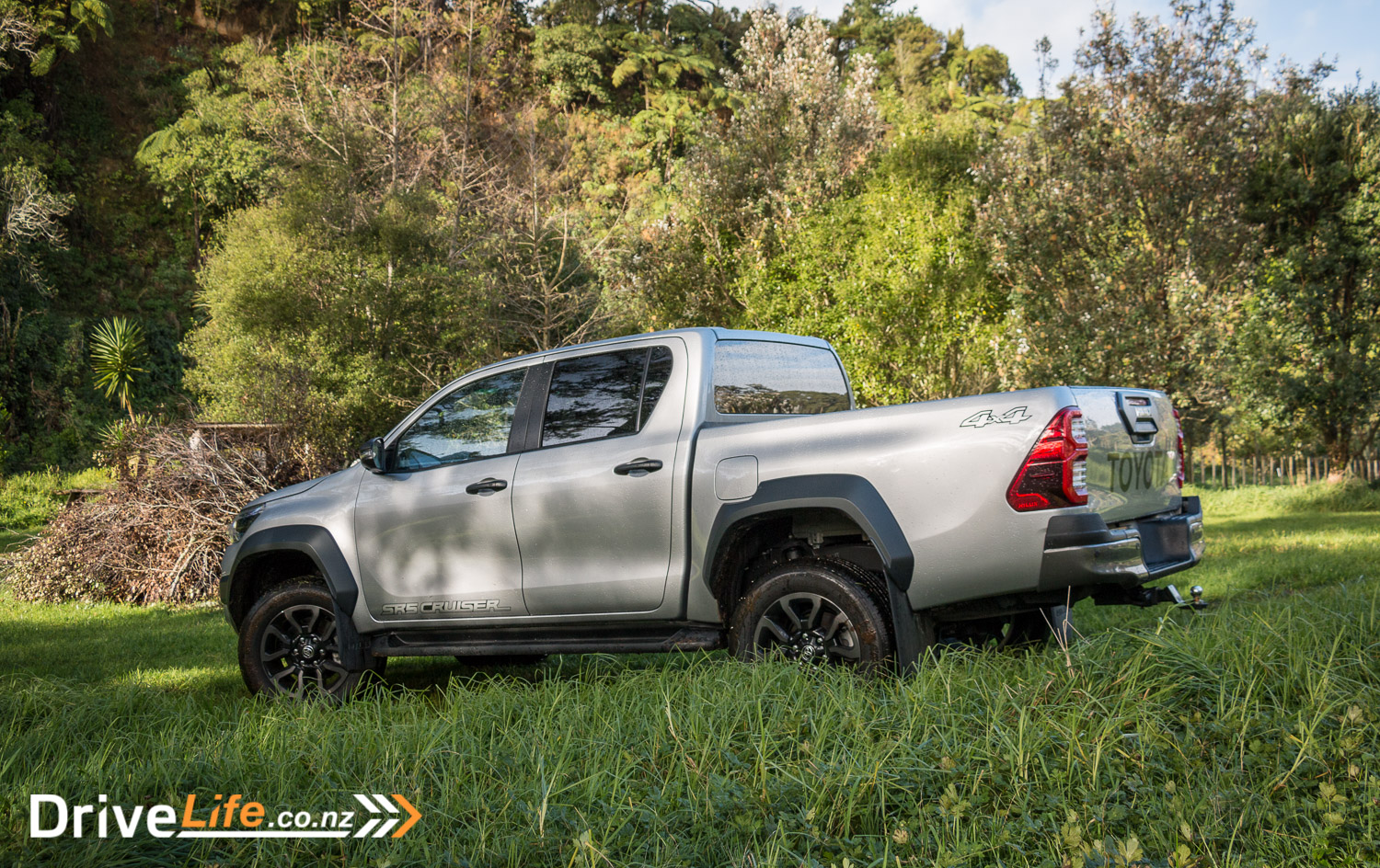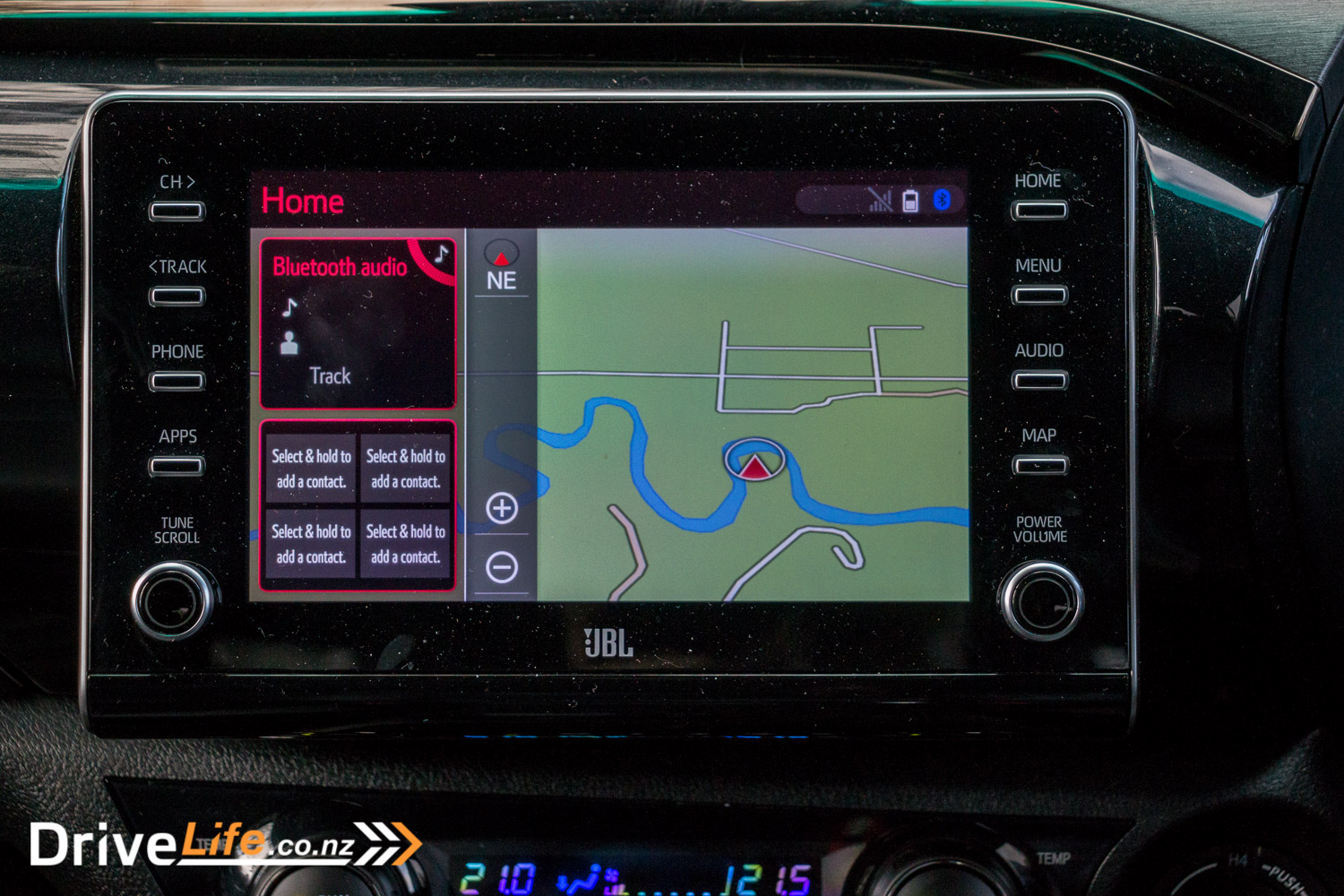The Hilux SR5 Cruiser was announced last year and promised a wider, taller Hilux with improved off-road capability, plus a more stable and comfortable driving experience on the open road. I drove it for a week to see how these claims stacked up.
Having recently moved to a rural property I have joined the ute life with a 30 year-old Ford Courier. When Toyota offered Drivelife the latest Hilux SR5 Cruiser I was keen to see how much progress had been made compared to my rather tired example.

What We Like and Dislike About The 2023 Toyota Hilux SR5 Cruiser
| What we like | What we don’t like |
| Handling Power Transmission Safety systems Cabin quality Looks | Ride quality (when not loaded) Camera resolution Radar cruise Front speakers |

What’s In The 2023 Toyota Hilux Range?
There are a lot of choices when you’re buying a Hilux, with the SR5 Cruiser sitting near the top of the range.
| Hilux SR PreRunner 2WD Double Cab – 6-speed manual | $43,390 |
| Hilux SR PreRunner 2WD Double Cab – 6-speed auto | $44,890 |
| Hilux SR5 PreRunner 2WD Double Cab – 6-speed auto | $48,390 |
| Hilux SR 4WD Double Cab chassis- 6-speed manual | $49,390 |
| Hilux SR 4WD Double Cab – 6-speed manual | $51,390 |
| Hilux SR 4WD Double Cab chassis- 6-speed auto | $51,390 |
| Hilux SR5 Cruiser PreRunner 2WD Double Cab – 6-speed auto | $48,390 |
| Hilux SR 4WD Double Cab – 6-speed auto | $53,390 |
| Hilux SR5 4WD Double Cab – 6-speed manual | $55,390 |
| Hilux SR5 4WD Double Cab – 6-speed auto | $57,390 |
| Hilux SR5 Cruiser 4WD Double Cab – 6-speed auto | $63,390 |
| Hilux GR Sport 4WD Double Cab – 6-speed auto | $74,990 |
| Hilux GR Sport 4WD Double Cab with Two Tone Paint- 6-speed auto | $76,490 |

2023 Toyota Hilux Standard Equipment Highlights
- Android Auto and Apple Carplay
- 9 Speaker JBL Premium Audio
- 8” central touch screen
- Satnav with SUNA Traffic Channel
- Pre-Collision System with Autonomous Emergency Braking, and Pedestrian and Cyclist Detection
- Dynamic Radar Cruise Control
- Lane Departure Alert with Yaw Assist function (Brake Control)
- Road Sign Assist
- Active Traction Contro
- ABS
- Blind Spot Monitor
- Brake Assist
- Down-hill Assist Control
- Drive-Start Control
- Electronic Brake-force Distribution
- Hill-start Assist Control
- Rear Cross Traffic Alert
- Traction Control
- Trailer Sway Control
- Vehicle Stability Control
- 7 airbags
- 2 ISOfix
- 2 Front and 4 Rear Parking Assist Sensors
- Reversing Camera with Panoramic View Monitor with Dynamic Guidelines
- Rear Privacy Glass
- 18” x 7.5” wheels
- LED headlights
- LED Daytime Running Lights
- LED Tail Lights
- LED fog lights
- Automatic Headlights, Follow Me Home Function and Automatic Levelling
- Door mirrors – Power Adjustments with Power Folding and Welcome Lamp
- Heated seats
- Driver’s Seat Power Slide, Recline and Height Adjustments
- Passenger Seat Manual Slide and Recline Adjustments
- Smart Entry and Push Button Start Systems
- Dual Zone Climate Control Automatic Air Conditioning
- Front Cool Box
- Accessory 220V Power Outlet
- Auto Dimming Interior Mirror
Including the optional equipment our review car’s retail price is $63,390
Colours available are
- Glacier White
- Graphite
- Eclipse (black)
- Emotional Red
- Nebula Blue
- Deep Sea Blue
For a full list of specs and options available for the Toyota Hilux SR5 Cruiser jump on over to the Toyota New Zealand website


How Does The 2023 Toyota Hilux SR5 Cruiser Compare To Its Competition?
All prices below exclude the refund or additional cost of the New Zealand Clean Car Programme.
SUV Comparison Chart
| Make/ Model | Engine | Power/ Torque kW/Nm | Fuel L/100km | Towing Capacity | Price (excl CCP) |
| Ford Ranger Sport | 3.0-litre, V6 turbo-diesel | 184/600 | 8.4 | 3,500 | $80,490 |
| Isuzu D-Max X-Terrain | 3-litre 4-cylinder turbo-diesel | 140/450 | 8.0 | 3,500 | $75,490 |
| Volkswagen Amarok V6 | 3.0-litre, V6 turbo-diesel | 190/580 | 8.9 | 3,500 | $75,000 |
| Mazda BT-50 Takami Wellside | 3-litre 4-cylinder turbo-diesel | 140/450 | 8.0 | 3,500 | $70,290 |
| Mazda BT-50 Limited | 3-litre 4-cylinder turbo-diesel | 140/450 | 8.0 | 3,500 | $63,790 |
| Toyota Hilux SR5 Cruiser 4WD Double Cab | 2.8-litre, 4-cylinder turbo-diesel | 150/500 | 9.5 | 3,500 | $63,390 |
| Mitsubishi Triton VRX | 2.4-litre, 4-cylinder turbo-diesel | 135/437 | 9.8 | 3,500 | $53,990 |

First Impressions Of The 2023 Toyota Hilux SR5 Cruiser
The new SR5 Cruiser certainly stands out – it’s tall, and that 120mm wider track, with matching fat plastic arches give it a real road presence. The huge black grille with its chrome inserts and the slightly frowny LED headlights give it an imposing face, and the fog lights have been integrated nicely into the new arches.
Apart from being a little taller, the side profile looks just like the previous SR5, with “SR5 CRUISER” and 4X4 graphics. It’s a good-looking overall package, with privacy glass on the rear windows and 18” alloy wheels. One thing that always niggles me as a design choice is the placing of the rectangular fuel filler door, so that they had to make a notch in the plastic arch to accommodate it. It just bothers me every time I see it.
The rear looks good with the traditional TOYOTA lettering on the tailgate, B-shaped tail lights and an integrated step in the rear bumper.

What’s The Interior Like In The 2023 Toyota Hilux SR5 Cruiser?
It’s quite a step up into the SR5 Cruiser, but there are side steps and grab handles in the A-pillars to help you get in more easily. Some of my passengers did complain a bit about having to climb into the vehicle. Once you’re in it’s very car-like with perforated leather, heated seats and a leather-clad steering wheel. The seats are comfortable and have enough side bolster support for everyday driving. The dash is solid-feeling with a straightforward design, integrating an 8” touch screen which will be familiar to anyone who has sat in a Toyota from the last five years. It has physical knobs and buttons, which we very much appreciate here at DriveLife.
The infotainment screen is connected to a 9-Speaker JBL Premium Audio system which gives a good, clear sound. There’s not a lot of bass even after tweaking the settings, but it’s well-balanced. Something we commented on with the previous model is still an issue with this one. The two speakers in the corners of the dash have a silver surround which reflects on the windscreen, and it catches your eye all the time as you’re driving.
Below the screen are the dual-zone aircon controls and a couple of power and USB sockets. The heated seat controls are lower down and are a bit odd, in that the top one controls the left seat and the bottom one the right, almost as though they are rotated 90 degrees; it’s not intuitive, especially when finding them on a dark morning.
There are two deep cup holders, I guess ute drivers like a large coffee as a medium cup gets a bit lost in there. There are also pop-out cupholders on the outsides of the dash which are less deep. There’s a manual handbrake lever, and a large centre cubby with a 220-volt socket inside for charging your tools.

The dash is the traditional two-dial layout with rev counter and speedo plus a centre screen for digital speedo, trip computer, off-road displays (such as wheel position), etc. Everything is clear and well laid-out and looks great at night with white and blue backlighting to go along with the blue ambient lighting.
The steering wheel controls are logical and easy to use. Cruise control is set via a third stalk which rotates with the wheel. Not my favourite way of doing it, but it works fine.
The three rear seats have enough leg room for an adult to fit, plus the 60/40 split base lifts up to reveal under-seat storage. There are handy hooks on the back of the two front seats, good for your takeaway bag to stop it falling over.
Out back there’s a plastic-lined tray which will do all the things you might want to do with a ute. There’s no damping on the tailgate, it’s heavy, and if you’re not ready for it, it’ll drop open with a clunk. This is standard for most utes, but I wish manufacturers would put some sort of damper on it to make it a bit safer.

What’s The 2023 Toyota Hilux SR5 Cruiser Like To Drive?
After driving most other cars including a lot of SUVs, the Hilux feels huge. Tall and wide, it gives a commanding view over other road users. Not so big that it doesn’t fit in car parks, but some will be a tight squeeze.
This new version is 120mm wider than the previous SR5 Cruiser, and 15mm taller. They’ve replaced the rear drum brakes with ventilated discs, and upgraded the front discs to 17-inch ventilated. Toyota say the suspension has been tweaked to give a better ride and handling, as well as the addition of a rear stabiliser bar. They say this means improved steering feel when cornering and changing lanes. All of these tweaks have a weight cost – the kerb weight is up 80-105kg depending on options. Quoted fuel consumption is up from 7.9 to 9.5 litres per 100km despite the same engine power and torque from the 2.8-litre 4-cylinder turbo diesel unit. There’s a 6-speed auto transmission with selectable four-wheel drive, and ther rear diff is an automated limited-slip unit with a manually engaged locking system for off-roading.
Often with utes and larger vehicles, I find that the high driving position reduces the impression of speed when you’re driving, and in a 50 limit area it can feel like you’re barely moving. The SR5 Cruiser is no exception, it’s really easy to drift up over the speed limit, and that’s where radar cruise is a really great feature to have. You can set it and let the car control your speed easily, and smart cruise means you can trust it to slow down where needed. But there’s a problem in the Hilux, go under 30kph and there’s a beep, and the cruise control turns off. This makes it pretty useless in rush hour traffic. On the open road it’s much better and works very well, though it’s over-cautious and slows down more than I would like on corners.
There’s traffic sign recognition and it works really well, showing the current speed on the screen and turning the icon red when you exceed that limit. Like all of these systems it’s not a hundred percent accurate, so you have to be alert.

Toyota have added more safety features to the SR5 Cruiser, including rear-cross traffic alert and blind spot monitoring, both of which are great. The one that I didn’t enjoy was Toyota’s lane departure warning system. It was turned off when I picked up the SR5 Cruiser, so I turned it on and it took me a little while to place when it was intervening as it is quite subtle, but annoying too. Sometimes it’ll beep when going too close to a line, other times it will intervene by pulling back the throttle just slightly. It feels like when a big gust of wind hits the car, or when one wheel goes through a puddle, and you feel that drag. It’s odd, and I really don’t like it. I switched it back off and left it off.
There’s a 360-degree camera system on the SR5 Cruiser which can be set to automatically come on when needed, in conjunction with the parking sensors. It works well but the resolution isn’t up to the standard of the European manufacturers so it’s more a general guide than a precision tool. Also, the beep of the parking sensors is really piercing!
So what’s the SR5 Cruiser like to drive? Mostly good. There’s ample power, and loads of torque. It feels like towing a boat wouldn’t trouble it one bit. Acceleration is effortless and it’s no slouch. The handing is excellent, it feels firm and planted on corners, and will easily cope with anything a New Zealand State Highway can throw at it. Stability and control are very good and those new brakes work very well.
Upon first impression it laughs in the face of potholes. But drive over a less-than-perfect road surface at 50kph and you realise that the secondary ride quality is jittery and unsettled. When you go over bumps or imperfections in the surface it does a little shimmy as the rear wheels make contact. I picked up my wife in the SR5 Cruiser one day and 30 seconds after we set off she said “Is there something wrong with this car?” It can make your lower body jiggle in an unpleasant way, similar to a sports car with hard suspension. It would be enough to put me off buying one, and I see that John said similar things about the ride in the previous model in his review.
I spoke to a work colleague who used to daily drive a Hilux and he said whenever we went on a road trip he would put two scoops of firewood in the back, then the ride was excellent. That’s all well and good, but in a very unscientific survey that I did over the week I had the Hilux, maybe 5% of utes that I saw had anything in the back. And I live in New Plymouth where there are a lot of utes.
What about off-road, you ask? I wasn’t able to fully test the off-roading abilities of the Hilux but I did drive up a very slippery, wet farm track, and I can tell you that the low-ratio mode got me out of a tricky spot and saved the grass from being sprayed all over a curious horse in the next paddock.
Finally, fuel consumption.On a combination of town and highway driving I averaged 9.3l/100km which is less than the advertised figure of 9.5l/100km.







2023 Toyota Hilux SR5 Cruiser – Specifications
| Vehicle Type | Double-cab ute |
| Starting Price | $63,390 |
| Price as Tested | $63,390 |
| Engine | 2.8 Litre common rail Turbodiesel 4-cylinder, 16 Valve Double Overhead Cam |
| Power, Torque kW/Nm | 150/500 |
| Transmission | 6-speed automatic Differential Lock and Auto Limited Slip Differential |
| Spare Wheel | Full-sized alloy spare |
| Kerb Weight, Kg | 2080-2135 |
| Length x Width x Height mm | 5325 x 2020 x 1830 mm |
| Fuel tank capacity, litres | 80 |
| Fuel Economy, L/100km | Advertised Spec – Combined – 9.5 Real-World Test – Combined – 9.3 Low Usage: 0-6 / Medium Usage 6-12 / High Usage 12+ |
| Towing Capacity Kg, unbraked/braked | 750/3500 |
| Turning circle metres | 12.6m Small: 6-10m / Medium 10-12m / Large 12m+ |
| Warranty | 5 years/150,000km warranty 5 years capped price servicing 5 years roadside assist 5 years WoF coverage |
| Safety information | ANCAP Rating – 5 stars – Link Rightcar.govt.nz –PJN718 |
Have you enjoyed this review? Be sure to join our monthly email newsletter list so you don’t miss a single car review!








